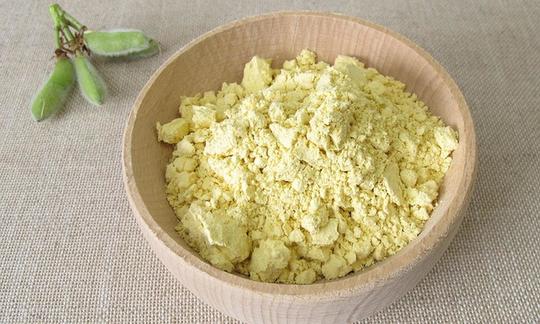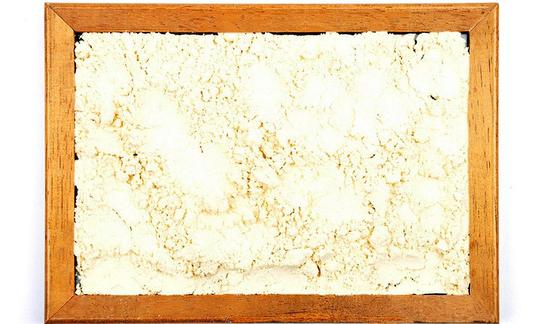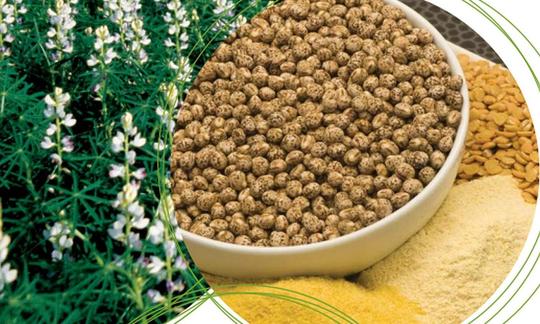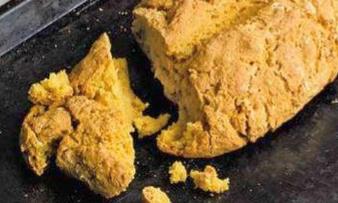Table of contents
To produce lupine flour , the seeds of cultivated and therefore non-toxic sweet lupine are used, mostly those of the white lupine ( Lupinus albus ). In stores, the flour is sometimes sold as lupine protein . Due to the high temperatures involved in the process, the product is usually no longer raw !
Use in the kitchen:
What does lupin flour taste like? The yellowish, slightly nutty-tasting lupin flour is very versatile. What can you make from lupin flour? Lupin flour is most commonly used as a substitute, e.g. for wheat flour in baking, as it binds water and helps keep it longer. As a guideline, you should replace a maximum of 15-20% of conventional flour with lupin flour. This way you can easily increase the protein content of cakes, muffins, pancakes, etc. and the baked goods taste lighter, airier and also have a yellowish color - even without eggs.
If you want to use lupin flour as a vegan egg substitute for patties, it is worth adding some starch (e.g. potato starch, corn starch ). Since lupin flour hardly contains any starch, it is also not suitable for thickening sauces or soups.
To replace an egg (vegan alternative), take about 15 g of lupin flour and 45 ml of water or a plant-based drink. You can also use this mixture as an egg substitute for a breading and then roll the product in breadcrumbs.
Due to the high protein content (approx. 38%), lupin flour can also be mixed into protein drinks (protein-rich drinks). However, the similarly produced lupin concentrate, also known as lupin protein isolate, is significantly richer in protein.
In addition, the lecithin contained in lupin flour acts as an emulsifier: the ingredients combine better. In the supermarket you can also find vegan "cheese" that contains lupin flour. Lupin tofu, a tofu-like product made from lupin flour, is also a particularly tasty source of protein. 2 The product marketed as "Lopino" is no longer available.
However, for vegan diets and products suitable for them, pure lupin protein (lupin protein isolate) is usually used to make milk substitute products such as yoghurt, cheese or ice cream; this protein has very little taste of its own. 1
In the Mediterranean region, pickled lupin seeds are known as a snack or delicacy in markets or inns (Italian: lupini, Spanish: altramuces or chochos).
If you roast the fruit, you get a coffee-like drink (e.g. Altreier coffee). 2
Vegan recipe for pizza dough with lupin flour and wheat flour:
Ingredients: 100 g whole wheat flour , 100 g white wheat flour , 100 g lupin flour, ½ cube of fresh yeast , 150 ml lukewarm water , 1 tbsp oil (e.g. cold-pressed rapeseed oil ), salt , possibly herbs (e.g. oregano , basil ).
Preparation: Dissolve the yeast in lukewarm water. Sift the flour into a large bowl, mix with salt and herbs. Then pour the yeast water and oil into the flour and use a wooden spoon or a food processor to make a smooth dough. Cover the dough and leave it to "rise" in a warm place for at least 1 hour. You can then roll out the dough as desired, add toppings and bake in the oven at 230 °C top and bottom heat for around 15-20 minutes. The lupine flour keeps the dough light and fluffy.
Recipe for vegan shortcrust cookies:
Ingredients: 100 g powdered sugar , 200 g vegetable margarine , 300 g wheat flour, 40 g lupin flour, 1 packet of vanilla sugar (or a pinch of pure vanilla ), 2 tablespoons water, juice of a small lemon .
Preparation: Mix the icing sugar, margarine, wheat flour and vanilla sugar in a bowl. Mix the lupin flour with water and lemon juice until smooth and add to the bowl with the other ingredients. Knead everything well with your hands until the dough is smooth and easily comes away from the bowl. Wrap the dough in foil and leave to rest in the fridge for about 30 minutes. In the meantime, preheat the oven to 180 °C. Roll out the dough and cut out shapes. Place the biscuits on a baking tray lined with baking paper and bake for about 10 minutes. Be careful when baking so that the biscuits are only slightly brown. After cooling, you can decorate the biscuits, e.g. mix icing sugar with a little water and spread it on top or refine them with chocolate icing, coconut flakes, nuts or colorful sprinkles.
Vegan recipes with lupin flour (lupin protein) can be found under the note: " Recipes that have the most of this ingredient ".
| Not only vegans or vegetarians should read this: Vegans often eat unhealthily. Avoidable nutritional mistakes . |
Shopping - where to buy?
Lupin flour is rarely found in common supermarket chains such as Coop , Migros , Denner , Volg , Spar , Aldi , Lidl , Rewe , Edeka , Hofer etc. Organic supermarkets (e.g. Denn's Biomarkt ), organic shops, health food stores, drugstores or smaller delicatessens, however, do offer lupin flour. You can usually find it there in organic quality or even produced under biodynamic guidelines (Demeter).
Altnatura sells lupin products in some stores, including lupin flour or lupin meal.
Found in the wild:
Wild forms of the white lupine ( Lupinus albus ), which is mainly used for lupine flour, no longer exist. Primitive forms ( L. graecus or L. termis ) can be found, however. These bitter lupines contain significantly more bitter substances in the form of alkaloids than the sweet lupines cultivated today. 3 Even in the wild species that bloom magnificently in gardens, all parts of the plant are poisonous. Wild species of the blue or narrow-leaved lupine ( Lupinus angustifolius ) can occasionally be found.
Storage:
Lupine flour should always be stored in a sealed container, protected from light and, above all, dry place. Since ground products are always more susceptible to pests than whole seeds, lupine flour should be used up quickly.
Ingredients - nutritional value - calories:
Is lupine flour healthy? Lupine contains all essential amino acids ( threonine , isoleucine , tryptophan , leucine , lysine , valine , phenylalanine and methionine ) and is a popular source of protein, especially among vegetarians and vegans. You can find out more about essential amino acids in the ingredient okara .
The protein content is about 38%, the carbohydrate content is 41%, of which about 30% is fiber. Fat is about 8.1%, and 100 g of lupin flour has a total energy content of 341 kcal. 4
In addition to the main nutrients mentioned, lupin flour also contains the trace element manganese (2.5 mg/100g), in a similarly high amount to that found in coconut flakes (2.7 mg/100g) and psyllium husks (2.6 mg/100g). Manganese is important for carbohydrate metabolism and connective tissue. Foods such as wheat germ (13 mg/100g), hazelnuts (6.2 mg/100g) and oat flakes (3.6 mg/100g) contain larger amounts of manganese. 4
Lupin flour also contains 188 µg/100g of folic acid (folate). According to EU regulations (2011), this is almost 100% of the recommended daily dose (200 µg). 5 The German Nutrition Society recommends that adults consume 300 µg of folic acid daily. 6 The manufacturing process and the associated heat treatment of lupin flour result in some of the folic acid being lost. Lupin meal contains significantly more folic acid at 355 µg/100g. Cooked lentils have a similar content to lupin flour at 181 µg/100g, while raw lentils contain 479 µg/100g of folate. 4 In general, pulses contain a lot of folic acid, but this is greatly reduced when cooked. Folic acid is very important for cell growth, protein metabolism and, of course, for the development of the fetus. An increased requirement (550 µg) 6 must be taken into account even before pregnancy.
Lupin flour also contains vitamin K , phosphorus , magnesium , potassium , copper and zinc .
You can find all the ingredients, the coverage of the daily requirement and comparison values with other ingredients in our nutrient tables. In the article Nutrients explained you will get a detailed insight into the topic.
Health aspects - effects:
Is lupin flour alkaline? Unlike many other legumes, lupin contains alkaline protein, which means that the body produces very little uric acid. This makes lupin particularly suitable for people who need to eat a low-purine diet as a result of rheumatism or gout.
Folk medicine - naturopathy:
Lupine seeds have been known in folk medicine since Hildegard von Bingen (against intestinal problems, colic). 16 Today, naturopathy attributes anti-cancer, antioxidant and antimicrobial effects to lupine.
Dangers - Intolerances - Side effects:
Lupins contain allergenic lupin proteins (conglutins), which can cause cross-reactions with allergens from soybeans, peanuts, green beans and peas. Symptoms can range from skin reactions, breathing problems and cramps to life-threatening allergic hypersensitivity (anaphylactic shock). 7
The obligation to declare lupins and their products is somewhat problematic because it does not apply equally in all countries. In the EU and Swiss law, there is a special labelling requirement for even the smallest quantities or components of lupins and products derived from them. Since 2008, lupin protein has been one of the "Allergens Fourteen"; these 14 main allergens trigger around 90% of all allergies. 8
In contrast to other legumes, lupin seeds cause significantly less flatulence.
The danger of the toxic substances contained in wild lupins, garden lupins or bitter lupins no longer exists in sweet lupins. Through targeted breeding, alkaloids such as quinolizidine, lupanine, 13-hydroxylupanine, sparteine and also multiflorine and lectins have been reduced in sweet lupins. 9
Cases of poisoning in livestock caused by alkaloids contained in wild lupins are well known. Spoiled feed can also cause lupinosis. A fungus ( Phomopsis leptostromiformis) colonizes spoiled feed, causing liver damage, especially in sheep, cattle and horses. 10
Occurrence - Origin:
Approximately 300 species are known from the genus Lupinus . They originate from two main gene centers: the Mediterranean region and the central part of the west coast of North, Central and South America. 3
Targeted breeding has produced the following species for grain production: The white lupine ( Lupinus albus ) from the Mediterranean region and the Andean lupine ( Lupinus mutabilis ) from the high altitudes of the central and southern Andes have been cultivated by humans for thousands of years. The yellow lupine ( Lupinus luteus ) and the blue lupine ( Lupinus angustifolius ) only became interesting for breeding to produce low-alkaloid sweet lupines in the late 1920s. 3 These are also suitable for growing areas such as Germany, Austria and Switzerland, which means that additional imports are unnecessary.
Cultivation - Harvest:
As a herbaceous, mostly perennial (sometimes annual) plant, the sweet lupine is very undemanding. It grows on sandy, even dry soils that do not even require fertilization. Its soil-improving effect makes it particularly interesting for organic farming. The nitrogen-fixing bacteria living on the root nodules enrich the soil with up to 100 kg of nitrogen per hectare. In addition, the roots, which can be up to 1.5 m long, loosen the soil and improve the rootability of subsequent crops. It is important to observe a cultivation break of at least 4 years. 11
Lupins reach a height of 80 to 120 cm, the thick flower candles can take up up to 50 cm. The flower color does not have to match the name of the lupin. The flower color of the narrow-leaved lupin, also called blue lupin, is very often white. The colors of the flowers range from white to violet, pink, red and yellow, and two-colored variants are also possible.
The round or flattened, rough to smooth seeds are enclosed in pods. Size and color can vary depending on the variety. The blue (narrow-leaved) lupine has smooth, gray-brown seeds with white spots (diameter approx. 7 mm), the multi-leaved lupine has spherical, grayish seeds with dark spots and the white lupine has flattened, white seeds, which sometimes have a black pattern (diameter approx. 8-10 mm). 12
Blue lupins are usually harvested at the end of August. At this point, the storage moisture should be around 14%; overnight drying is necessary. 13
A particular plant disease, anthracnose (scorch), is causing problems for organic lupin cultivation, especially white lupins. It is caused by fungi such as Colletotrichum acutatum or Glomerella cingulata . Varieties of blue lupin are resistant to this disease.
Production of lupin flour:
To produce lupin flour, lupin seeds are pressed into flakes. To increase digestibility, they are soaked in water. This process removes the protein dissolved in the fiber structure. The high-quality protein is dissolved in the resulting milky liquid. After the liquid has evaporated, the powder that remains is usable as lupin flour. 14
When making lupin products, such as tofu substitute, the manufacturing process is similar to that for flour. However, the protein concentrate is used here, which has a consistency similar to curd. The lupin seeds are soaked and ground into a thick mash. The so-called "lupin milk" is pressed from this. The heating process is much less here. At around 85 °C, the protein contained in it flocculates after around 50 minutes. The "whey" is then separated. The resulting mass is mechanically dewatered in a "press box", where it is also processed into the desired end product (e.g. patties, spreads, etc.). 14 When dried to powder, the lupin protein isolate (lupin concentrate) has a protein content of over 90%. 15
Depending on the further use, the starting product is either white sweet lupine (for example for meat or cheese substitutes) or blue sweet lupine (for vegetable protein powder).
In contrast to lupin flour, lupin meal is a coarser product. The lupin seeds are crushed in a roller. Because the seed shells are destroyed, they are more likely to rot, which is why they are often heated (toasted) before being sold. This means that this product is usually no longer raw.
Animal protection - species protection - animal welfare:
With their colorful flowers, lupins are a great source of nectar for bees and bumblebees during flowering season.
General information:
The plant genus Lupinus belongs to the subfamily Faboideae and the family Fabaceae or Leguminosae. Peas , chickpeas and groundnuts also belong to the same family.
According to Wikipedia , the most common lupine in Central Europe is the multi-leaved lupine ( Lupinus polyphyllus ). 2
Alternative names:
The name lupine probably comes from the Latin "lupus", which means wolf. The reason for the name is unclear. This is why lupine is also known as wolf bean, and the name fig bean is also known. The white lupine ( Lupinus albus ) is called white lupine or field lupine. Lupine seeds are known as lupine or lupini beans, and lupine flour is translated as lupine flour. Lupine protein isolate is known as lupine protein isolate (LPI).
Literature - Sources:
Bibliography - 16 Sources
| 1. | Prolupin GmbH. Prolupin entwickelt pflanzliche Lebensmittelzutaten ohne Eigengeschmack. 2010. |
| 2. | Wikipedia Lupinen. |
| 3. | Bibd.uni-giessen.de Gattung Lupinus L. von W. Schuster. |
| 4. | USDA United States Department of Agriculture. |
| 5. | Amtsblatt der Europäischen Union. Verordnung (EU) Nr. 1169/2011 des Europäischen Parlaments und des Rates vom 25. Oktober 2011 betreffend die Information der Verbraucher über Lebensmittel. |
| 6. | DGE Deutsche Gesellschaft für Ernährung. |
| 7. | BfR Bundesinstitut für Risikobewertung. Allergie durch Lupineneiweiss in Lebensmitteln. Aktualisierte Stellungnahme Nr. 039/2011 des BfR vom 26. August 2011. |
| 8. | Pini U. Das Bio-Food Handbuch. Ullmann: Hamburg, Potsdam. 2014. |
| 9. | Wikipedia Weisse Lupine. |
| 10. | Jago MV, Peterson JE et al. Lupinosis: response of sheep to different doses of phomposin. Australian journal of experimental biology and medical science. 1982;60(3) |
| 11. | Fibl.org Merkblatt Biolupinen. 2012. |
| 12. | Reiner H. Die Lupinen - Warenkundliche Grundlagen für die Müllerei. Ausarbeitung für die Mantler Mühle. Wien. 2007. |
| 13. | Oekolandbau.de Lupinen. |
| 14. | Lupinen-samen.info Verwendung der Lupine. |
| 15. | Ufop.de Union zur Förderung von Oel- und Proteinpflanzen e.V. Lupinen in der Humanernährung. |
| 16. | Hildegard von Bingen. Physica. Lib. II, Cap. IX: De Vichbona. |















Comments